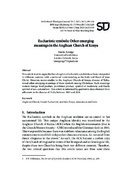| dc.contributor.author | Kiarie, George | |
| dc.date.accessioned | 2018-10-05T09:52:17Z | |
| dc.date.available | 2018-10-05T09:52:17Z | |
| dc.date.issued | 2017 | |
| dc.identifier.citation | Stellenbosch Theological Journal, 2017, Vol 3, No 2, 439–456 | en_US |
| dc.identifier.issn | 2413-9467 | |
| dc.identifier.uri | https://karuspace.karu.ac.ke/handle/20.500.12092/2162 | |
| dc.description | DOI: http://dx.doi.org/10.17570/stj.2017.v3n2.a20 | en_US |
| dc.description.abstract | This article is set to argue that for a long time Eucharistic symbols have been interpreted in different contexts, with a universal understanding as the body and blood of Jesus Christ. However, recent studies in the Anglican Church of Kenya, diocese of Thika, reveal other emerging meanings of these symbols among Christians. Such meanings include foreign food product, prohibited product, symbol of modernity and finally symbol of neo-colonialism. This article is informed by qualitative data obtained from adherents in the diocese of Thika between 2013 and 2014. | en_US |
| dc.language.iso | en | en_US |
| dc.publisher | Stellenbosch Theological Journal | en_US |
| dc.subject | Anglican Church | en_US |
| dc.subject | bread | en_US |
| dc.subject | Eucharistic symbols | en_US |
| dc.subject | Kenya; | en_US |
| dc.subject | missionary and wine | en_US |
| dc.title | Eucharistic symbols: Other emerging meanings in the Anglican Church of Kenya. | en_US |
| dc.type | Article | en_US |
